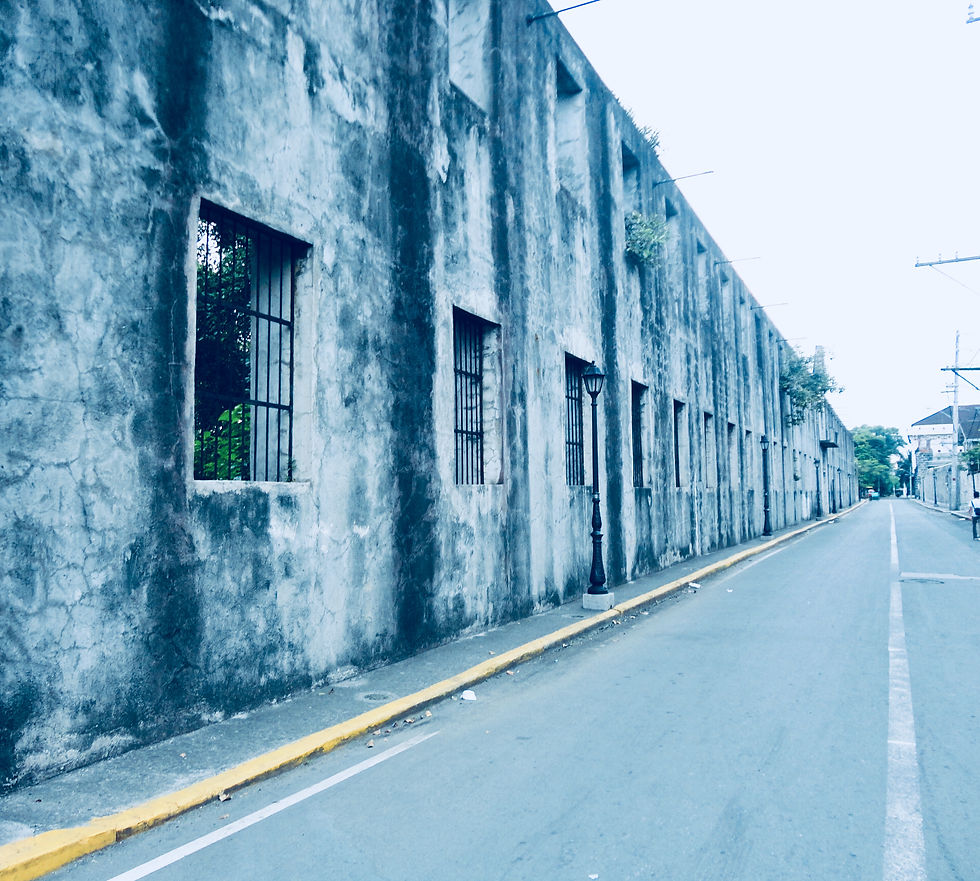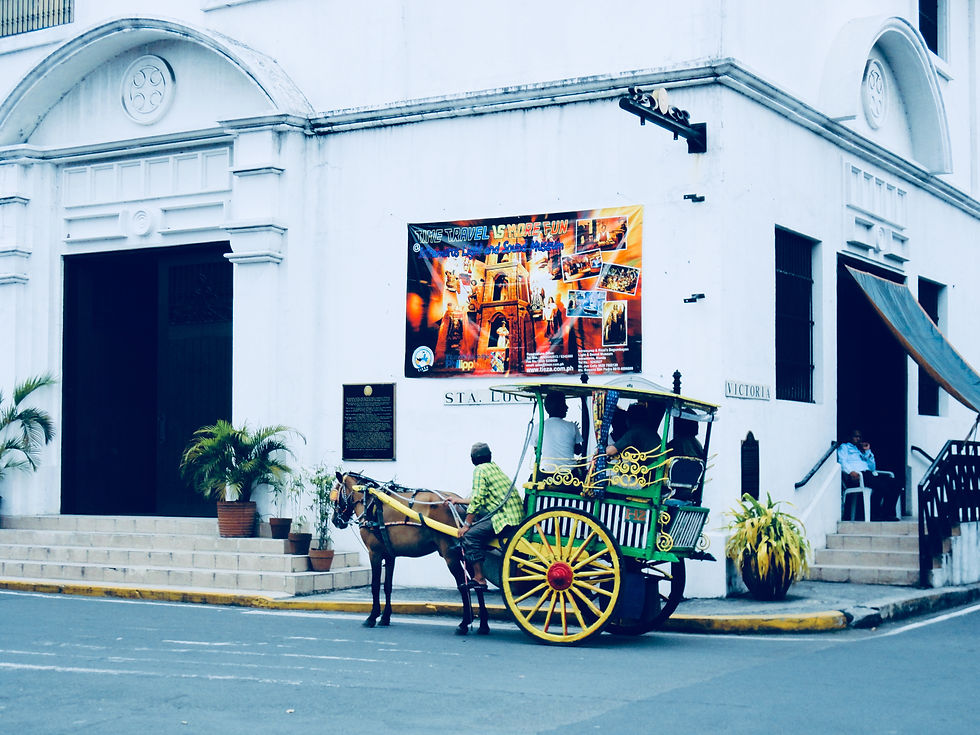- Tina Pascual

- Dec 5, 2019
- 4 min read
Updated: Aug 31, 2020
Intramuros is a Spanish term which literally means, “within the walls”. Thus it is also called, “Walled City”. It was built in 1571 by the Spaniards when the Philippines was under their colony. The walled city was a seat of their power and was erected to protect the place from foreign invasion.
Today, the city is a charming site that owns an architecture of the 16th century - different from the modern extramuros (the places outside the wall). Intramuros, still holds its glory, owning universities, churches, hospital, gardens, shops, golf course and government establishments.
As a former student from one of the university within the wall, few of my favourite sites are listed below:
1. Baluarte de San Diego
The Baluarte was created and erected in a sturdy manner for the purpose of sheltering the people in times of war. At present, the administration of the city had preserved and beautified the place with a garden which welcomes the visitors.
Entrance Fee: 75 Philippine peso (US$1.50) for adults, 50 Php (US$1) for students.
Suggestion: Go up the wall at the second level of the site to get the best view of the Club Intramuros Golf Course and the oldest premier hotel in Manila, the Manila Hotel.
2. Fort Santiago
The Fort Santiago is actually the main tourist attraction of the city. It is built as a defence citadel that was later on converted as a military barracks during world war. The site also plays an important role in the history of the Philippines as it is where the national hero, Dr. Jose Rizal was kept captive by the Spaniards.
Today, the fort serves as one of the most important historical landmark of the country. Tourists enjoys the attractive manicured garden, poignant ruins, and the Rizal shrine and museum inside the park.
Operating Hours: 8AM - 7PM.
Entrance Fee: 75 Philippine Peso (US$1.50) per head.
Suggestions: Stand atop the Postigo de la Nuestra Senora del Soledad or the Falsabraga de Media Naranja located at the north east end of the park to observe the iconic Pasig River.
3. Palacio del Gobernador
A government building with reddish facade that houses the Intramuros Administration and the country's Commission on Elections.
Suggestion: Bank and ATM machines surrounds the area for any of your financial needs as well as convenience stores.
4. Casa Manila
A cultural house museum with a colonial and charming edifice presenting the lifestyle of the Spaniards during their occupation. Casa, which means ‘house’, portrays an actual picture and paraphernalia of their home.
Operating Hours: 9AM- 6PM.
Entrance Fee: 75 Philippine peso (US$1.50) for adults; 50 Php (US$1) for students, senior citizens and teachers.
Suggestions: Try checking out interesting souvenir shops around the Casa.
5. Puerta del Parian
'Puerta' is a Spanish word for opening or gate. The Parian gate is built to serve as a passage to connect the city to the Chinese merchants that are housed adjacent to the gate. To date, it is an interesting site to behold. It also owns the ASEAN garden with sculptures of important leaders.
Suggestion: Check out shops and cafes located at the wall just before going out the gate. The cafeteria caters cheap student meals of various selections.
6. Puerta Real
Puerta Real is another gate in Intramuros originally built facing the Bagumbayan, now called Luneta. During the Hispanic period, it holds events for the state’s governor general.
To date, still, a charming garden embraced the area and is managed for exclusive beautiful outdoor events (especially weddings). However, only the puerta is passable for the public.
Suggestion: Try passing to the gate during the weekend night where you can take a glimpse (or gatecrash) an ongoing lovely wedding or reception to get inspired.
7. Baluarte de San Francisco de Dilao
Located just above the front of a prominent engineering school. The space was originally laid as a defence against the Chinese inhabitants living around the exterior of the city. It showcases canyons used during the war.
Suggestion: It is awesome to view the sunset, Manila City Hall, golf course and Manila skyline by climbing up the wall. Also, try to go from either both sides of the alley. The North will lead you up to Puerta de Isabela (another interesting gate facing and leading to the famous Chinatown) and the South will lead you up to Baluarte de San Deigo - and maybe further ahead since the wall encircled the city. Along the way, there will be little and nice interesting spots.
8. Manila Cathedral
The cathedral, was built in 1571 and still holds its prestige after numerous restorations from war and damages because of natural calamities. It is dedicated to the Immaculate Conception of the Blessed Virgin Mary.
Suggestion: Plaza de Roma is just across the cathedral where you can toss a coin and make a wish or prayer at the fountain. Also, you can meet the statue of King Charles IV of Spain.
9. San Agustin Church
San Agustin was constructed in 1720 during the Spaniard occupation of the country. The church was tagged as UNESCO world heritage site in 1993 and was also a National Historical Landmark. Its symmetrical interiors doesn’t fail to amaze both the parishioners and the visitors. During the World War II, it was used as a concentration camp and was the only structure left standing after a massive destruction of the walled city. In addition, the church was also labeled as the wedding capital church of the Philippines as hundreds of vows took place here every year.
Suggestions: Consider attending a mass which mostly held in English and be blessed.
10. San Agustin Museum and Father Blanco’s Garden
The museum is located beside the San Agustin Church and it keeps church’s and religious artefacts, painting and statues. Whilst, the little garden is constructed in honour of a botanist priest also known as the ‘Father of Philippine Botany’. The spot is lovely for photo-taking.
Operating Hours: 8AM - 12NN and 1PM - 6PM.
Entrance Fee: 200 Philippine peso (US$4) for adults and half the price for students who have their ID’s.
Addendum:

Intramuros had been greatly damaged by wars and natural calamities and was rebuilt every now and then to preserve its historical prestige. Some of the edifice are actual ruins, some areas are renovated using bits and pieces of the originals and some are replicas.
Nevertheless, the city looks lovely with portions of streets made with cobblestones. It is mainly appreciated and toured by foot as there were no public vehicles allowed inside. Other option is to take a kalesas (a horse ride using a two-wheeled carriage). They roam around for a fast track street tour.

*information confirmed via internet research.
RELATED TOPIC:


















